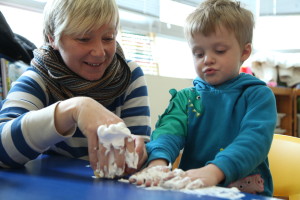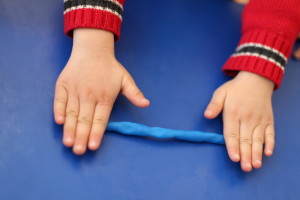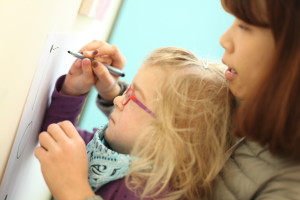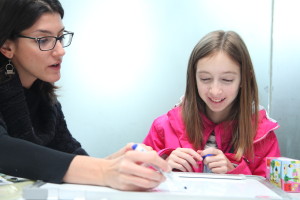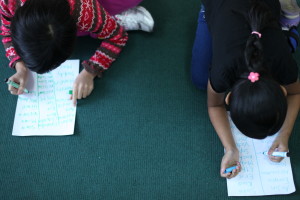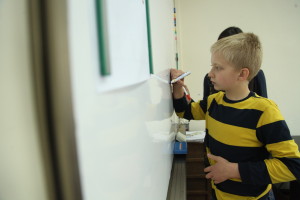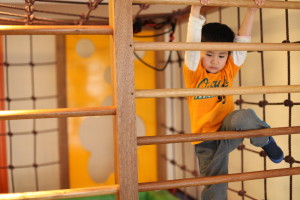Some of the most frequent questions we get from parents and teachers concern children who have difficulty with writing. We asked one of our occupational therapists, Chantal Chen, to outline how to go about identifying and remedying some of the common problems children have in writing.
“Children aged two to six can experience many difficulties learning how to write,” Chantal told us. “When writing, the whole body is used; from the feet to the fingers. Everything must be in harmony.”
Before helping a child, either in the classroom or at home, the first thing you need to do is observe where and how they are experiencing difficulty. Then you can tailor your time together to a specific area. Below are six common observations and the tasks you can do to aid development.
1. Sensory information
Observation: Child has problems telling different materials apart.
Why this is a problem: Children need to be able to tell if they are holding a marker, pencil, or pen, and act accordingly, with appropriate force.
Task: Provide objects of varying textures, such as rough fabric or shaving foam. Ask the child to feel and describe them, focusing on the differences. Then, give the child chalk and ask them to write on a chalkboard. This will give a greater connection between their movements and the resulting written shapes.
2. Finger differentiation
Observation: Child has problems moving fingers independently of each other.
Why this is a problem: In order to write one must keep the fourth and fifth fingers still while moving the other three.
Task: Ask the child to thread small beads. This requires only the thumb and first two fingers of each hand. Then get them to put coins in a piggy bank, which does the same.
3. Hand strength and dexterity
Observation: Child is generally inaccurate with hand movements, and has low stamina while writing.
Why this is a problem: You need strength and dexterity to precisely manipulate an object such as a pen.
Task: Ask the child to pick up objects with tongs and place them in a line. Start with something light such as cotton wool balls. Make sure that they are only using their thumb and first two fingers. Then bury marbles in play dough and get the child to dig them out, which works on overall hand strength.
4. Forearm stability
Observation: Child has difficulty supporting writing hand with a still and strong forearm.
Why this is a problem: If you want to write and move freely while writing you need the forearm to provide a stable base.
Task: Ask the child to lie on their front and read or do colouring. This will naturally mean they have to support themselves using their forearms.
5. Forearm isolation
Observation: Child tends to move hand and forearm together, rather than using the forearm as a base. This will often lead to the child gripping the writing implement too hard.
Why this is a problem: Without isolation of movement, the writing will be forced and unnatural, rather than relaxed and neat.
Task: Ask the child to write on a vertical surface. They will have to put their forearms against the walls to steady themselves, then move their hands independently.
6. Shoulder, arm and body strength
Observation: Even with a correctly sized chair and table, child is unable to maintain the proper writing position, i.e. straight back with back, thighs and shins each at ninety degrees to each other.
Why this is a problem: Writing requires the whole body to be powerful and stable. If the problem is not in the chair and table it means that the child’s overall strength may be too low.
Task: Ask the child to progress across a set of monkey bars. If they cannot do this, instead get them to hang and count to ten. This will quickly build shoulder and core strength.
Each of these tasks should be done for twenty minutes, five days a week, ideally before whatever writing tasks the child has to do. Make the tasks as fun as possible; be engaging, and try to incorporate playing and playfulness as much as possible. Observe, then remedy specific problems, and with these small activities, you can really help a child’s development. And if you ever have any doubts, come in and talk to a specialist, we are always glad to help.
Chantal Chen, M.Res
Occupational Therapist
Prior to joining us, Chantal had more than 4 years of Occupational Therapy experience and working with children. She is enthusiastic about the importance of communicating with the caregivers of the child to bring positive changes to the child’s life.

